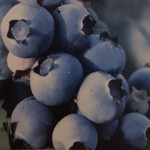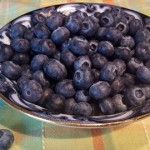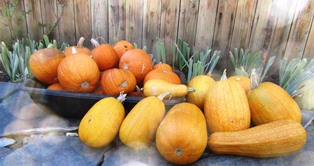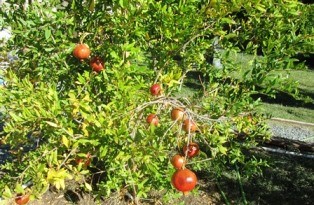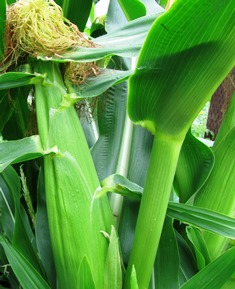Backyard Blueberries Taste Delicious and Are Easy to Grow
What’s not to love about blueberries. They’re almost a a perfect fruit. They are delicious, packed full of antioxidants, easy to grow, and add lovely landscape interest to any garden.
Grow blueberries in containers or in the ground but keep in mind that these plants like well-drained acidic soil. The pH should be on the low side, ranging from 4.5 to 5.5.
In the hottest inland valleys of the Bay Area, blueberries do best with morning sun and shade for hot afternoons. Northern Highbush varieties require winter chilling (800 to 1000 chill hours) to get the plants to produce fruit. Southern Highbush blueberries require from 700 to 1000 chill hours.
These plants benefit from an organic fertilizer with nitrogen.
Hold off on pruning for up to three years, allowing the plant to develop both a strong root system and bushy foliage. New plants begin to produce berries around the third year. During the third year, start pruning twice a year to remove inner and crossing branches to let in light and reduce the possibility of foliage disease.
Of the dozens of varieties of blueberries on the market today, among the Southern Highbush types is an early cultivar known as Misty. It produces a medium to large berry that is both sweet and spicy. The bush is upright with leaves that are blue-green turning to burgundy in autumn.
Sharpblue is another Southern Highbush variety that needs only 200 chill hours and produces dime-size fruit in abundance. The leaves remain green through fall and the bush is an outstanding specimen with high ornamental value in any garden.
For exceptional large berries with a robust flavor, give Southmoon a try. The berries are sweet; the plant, upright and vigorous. The plant will require 400 chill hours and will perform best in a sandy soil with lots of organic matter.
Whether you like your blueberries picked from the bush to eat fresh or baked into a delicious pie, give this plant a try. If you provide your blueberry plant the nutrients, sunlight, and water it requires, it will reward you with luscious fruit year after year.
_____________________________________________________
Order a copy of The Self-Care Planner for ideas about how to care for yourself. https://www.simonandschuster.com/books/The-Self-Care-Planner/Meera-Lester/9781507211649

Check out the Henny Penny Farmette series of cozy mysteries. Available for purchase from online and traditional bookstores everywhere
Growing Blueberries in the Bay Area
My Henny Penny Farmette is not far removed from ranch land populated by cows and dotted with towering oaks and pines. In the blistering heat of summer, the surrounding hills and canyons support little more than star thistle and wild grass that dries to become the perfect tinder for wildfires. Until recently, I doubted I could ever successfully grow blueberries that need the moist, acidic soils, more common to the Northeast and deep South.
However, after reading the University of California paper on growing blueberries here in the West, especially in the nearby Central Valley and also the Santa Clara Valley, I decided to try a couple of plants. See, http://ucce.ucdavis.edu/files/filelibrary/5842/25993.pdf.
I chose to grow Sharpblue (a southern highbush type of blueberry). These plants have beautiful blue-green foliage and a compact growing habit. When they reach their full height, they will stand 6-8 feet high and 4-6 feet wide. The plants are self-fertile.
This plant produces both flowers and fruit throughout most of the year; the fruit can be picked from midsummer through the fall. To my surprise, the plant bore fruit this year.
Northern lowbush blueberries grow well in northern U.S. states and in Canada where moist soil and long hours of winter chilling fulfill the plant’s growing requirements.
For best results in the Bay Area, choose highbush blueberries such as the following: Sharpblue, Sunshine Blue, Bluecrop, Blueray, Ozark Blue, Georgia Gem, Misty, Reveille, Cape Fear, and O’Neal. Plant them in acid soil that drains well and is porous.
They may also be planted in containers on patios but require plenty of water and six hours of sun. In the hottest areas, provide part sun/shade.
Blueberries taste great in pancakes, muffins, strudels, and coffee cakes. They’re delicious in jams or stirred into yogurt (my favorite). Just a single cup of this low-cal fruit is packed with Vitamin C, fiber, and antioxidants. Freeze extra berries to enjoy later.
Try making this taste-pleasing recipe posted online at WebMD.com for Blueberry Nectarine Granola Crisp. See, http://www.webmd.com/food-recipes/features/blueberries-nutritious-things-come-in-small-packages_
_______________________________________________________________
If you enjoy reading about farmette topics, gardening, and keeping chickens and honeybees, check out my series of cozy mysteries from Kensington Publishing in New York.
Click on this link: http://tinyurl.com/ya5vhhpm
Click on this link to see The MURDER OF A QUEEN BEE: Click on this link: http://tinyurl.com/yd7pz7af
Protecting Your Backyard Flock in a Heat Wave
I lost a chicken this morning despite taking measures to protect her from the deadly heat wave we’ve been having here in the Bay Area. The last thing someone attached to their hens ever wants to see is one of her precious little girls gone. Mine was a Silver Laced Wyandotte (who leaves behind a sister) and five other hens with whom she was raised.
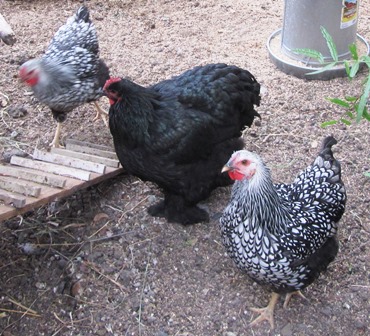
The Silver Laced Wyandotte (black-and-white) hen in the foreground succumbed to the extreme heat sometime during the night
Our farmette sits in the east bay hills and too far inland from the San Francisco Bay or the delta (which flows to Sacramento) to gain much benefit from cooling breezes off the ocean. We’ve had triple digit temps on the farmette for days.
I put out extra water basins for my chickens, kept their doors open in the chicken house at night (there is a wire run with a wire ceiling to protect them when they’d rather roost outside), and fed them frozen corn, cool seedless watermelon treats, and chilled grapes.
The chicken house has windows that I keep open (they have reinforced wire over the screens). I reduced the amount of litter on the floor (I use ground corn cob) since it could hold the heat.
I haven’t install a fogging system or fans, but I might if this heat keeps up.
The only telltale sign that my hen was in trouble was that she seemed to exhibit lethargy and to have lost weight (although it was difficult to tell under all her feathers).
Her comb had turned slightly pale and seemed to have shrunk in the last 24 hours. When I check on her last night she was turning herself to face the wall. Not a good sign since, in my experience, I’ve seen chickens do this before they pass away.
Some strategies for helping backyard chickens survive extreme heat include the following tips.
Eight Strategies to Help Chickens Beat the Heat
1. Make sure windows of chicken houses face north to south to allow breezes to blow through, rather than face east to west (rising and setting sun).
2. Keep litter on the chicken house floor low (1 to 2 inches is sufficient).
3. Position your chicken house under a tree, if possible, where the structure receives shade.
4. Make certain you have several watering dispensers (placed in the shade) with clean, fresh water every day during hot weather.
5. Add ice cubes to the watering canisters.
6. Put out treats such as bowls of frozen corn and cool, seedless watermelon, and chilled grapes or blueberries.
7. Use a fan, if necessary to remove heat from the chicken house.
8. As an emergency measure for a chicken that looks distressed, dip her in cool water.
To-Do List of Chores for the Fall Garden
From my office widow, I look out over what once was a lush and thriving garden. Not so today.
I can hardly bear to gaze upon the sorrowful, dried tomato vines that for me have come to symbolize the severity of the extreme drought on California gardens.
Now that fall will soon arrive, I’ll toss onto the compost pile those vines along with others from pumpkins and hard-shelled squash.
So with the garden cleared, I’m thinking ahead to next year, ever hopeful we’ll get rain rather than a repeat of dry conditions like this past year.
To ensure the viability of our fruit trees, citrus trees, and various berries through the fall and winter, there is a spray regimen to be initiated. I’ll add it to my long list of chores that will need to be done.
MY FALL CHECKLIST FOR THE GARDEN
Turn the soil, add amendments like compost to hold in the water.
Prepare new beds.
Build cold frames and 4- x 6- foot boxes for new raised beds.
Cut the canes of blackberries (berries only set up on two-year-old canes that won’t again produce; cut to ensure new fruiting canes will take their place).
Prune away the spent floricanes of red raspberries, once they’ve produced fruit.
Clean up around the bases of all trees and evergreen plants; add mulch.
Also remove all leaves at the base of all fruit trees and dispose.
Remove rose leaves after blooming season, cut canes to 18 inches, and spray for diseases and pests.
Stake young trees so they’ll survive windy winters, growing straight and tall.
Treat the trees with an organic spray (one containing copper and protector oil) to prevent fungal disease and pests.
Get out the frost cloth in readiness to cover tender citrus trees.
Prune back the hydrangeas.
Plant fall bulbs for spring flowering.
Summer Garden in Review

Red onions, grown from sets laid onto prepared beds of soil and barely covered with dirt, produced bulbs all summer
As I prepare and amend planting beds to sow some cool season crops, I am also reviewing my summer garden. I will be the first to admit it was less than a stellar year for my vegetables, except for the peppers, eggplants, summer squash, cherry tomatoes and the sweet French pumpkins for pie, Rouge Vif d’Etampes.
We bought seedlings of heirloom tomatoes and also grew some plants from seed (captured and preserved from last year). The paste tomatoes produced abundantly, but I didn’t get many slicing tomatoes and the cantaloupe and Armenian cucumber plants performed dismally for me. Last summer, those two were star performers in my garden.
The German heirloom Riesentraube (the name means “giant bunch of grapes”) will produce sweet, red 1-ounce fruits, if they ever ripen. The plant’s vines have spread like a wild weed all over the garden and are covered in blooms. The plant is a heavy producer but the fruit is still green. To be fair, I planted this one later than the other heirloom tomatoes, so it may yet surprise me.
Of the blue-black tomatoes we planted, the most notable are Blue Beauty and Indigo Apple. I loved the taste and the thin skin of Blue Beauty but Indigo Apple’s small fruit, despite being described as sunburn and crack resistant, suffered from both in my summer garden.
My patch of sweet summer corn produced lots of ears but quickly became infested with corn aphids that I had difficulty controlling. Finally, I ripped out the whole patch.
We had an abundance of raspberries and strawberries this year. Although we picked strawberries every morning from early May throughout the summer, those strawberries kept on blooming and producing. The blackberries produced lots of vines, but few berries. My blueberry bush went into the compost pile–the soil is too clay and alkaline. I’ll try growing one next year in a wine barrel with acid soil, maybe adding some pine needles, sulfur powder, peat moss, and sawdust mulch.
Our White Genoa fig tree is loaded with ripening figs and the Fuji apple, a few feet away, has branches needing support for the low-hanging, heavy apples. We picked and ate all the sweet summer-ripening Bartlett pears. Now, while we await the fall pears ripening, we’ll keep an eye on the blood oranges from which I hope to make marmalade in late winter when the fruit on the citrus trees ripens.
So, in review, this summer’s garden wasn’t the best. But gardeners, myself included, are eternal optimists, ever dreaming of the next plant, the next season. As English writer and gardener Vita Sackville-West astutely observed, “The most noteworthy thing about gardeners is that they are always optimistic . . . always look forward to doing something better than they have ever done before.”
 Facebook
Facebook Goodreads
Goodreads LinkedIn
LinkedIn Meera Lester
Meera Lester Twitter
Twitter





